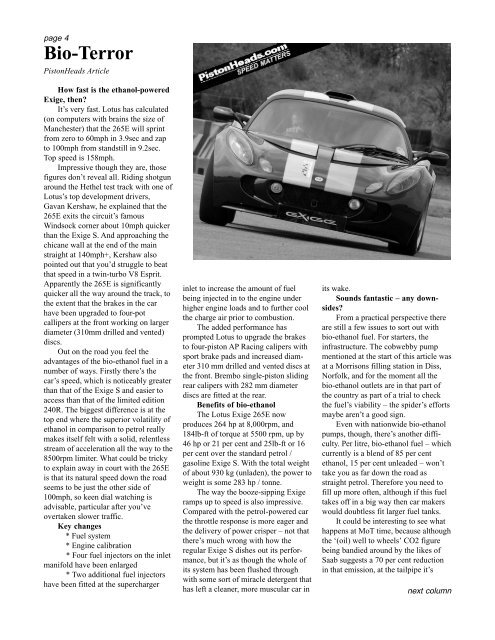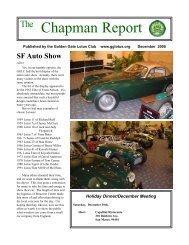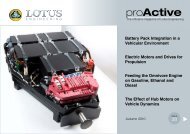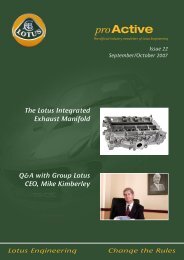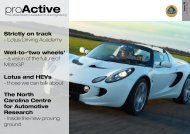Chapman Report - Golden Gate Lotus Club
Chapman Report - Golden Gate Lotus Club
Chapman Report - Golden Gate Lotus Club
You also want an ePaper? Increase the reach of your titles
YUMPU automatically turns print PDFs into web optimized ePapers that Google loves.
page 4<br />
Bio-Terror<br />
PistonHeads Article<br />
How fast is the ethanol-powered<br />
Exige, then?<br />
It’s very fast. <strong>Lotus</strong> has calculated<br />
(on computers with brains the size of<br />
Manchester) that the 265E will sprint<br />
from zero to 60mph in 3.9sec and zap<br />
to 100mph from standstill in 9.2sec.<br />
Top speed is 158mph.<br />
Impressive though they are, those<br />
figures don’t reveal all. Riding shotgun<br />
around the Hethel test track with one of<br />
<strong>Lotus</strong>’s top development drivers,<br />
Gavan Kershaw, he explained that the<br />
265E exits the circuit’s famous<br />
Windsock corner about 10mph quicker<br />
than the Exige S. And approaching the<br />
chicane wall at the end of the main<br />
straight at 140mph+, Kershaw also<br />
pointed out that you’d struggle to beat<br />
that speed in a twin-turbo V8 Esprit.<br />
Apparently the 265E is significantly<br />
quicker all the way around the track, to<br />
the extent that the brakes in the car<br />
have been upgraded to four-pot<br />
callipers at the front working on larger<br />
diameter (310mm drilled and vented)<br />
discs.<br />
Out on the road you feel the<br />
advantages of the bio-ethanol fuel in a<br />
number of ways. Firstly there’s the<br />
car’s speed, which is noticeably greater<br />
than that of the Exige S and easier to<br />
access than that of the limited edition<br />
240R. The biggest difference is at the<br />
top end where the superior volatility of<br />
ethanol in comparison to petrol really<br />
makes itself felt with a solid, relentless<br />
stream of acceleration all the way to the<br />
8500rpm limiter. What could be tricky<br />
to explain away in court with the 265E<br />
is that its natural speed down the road<br />
seems to be just the other side of<br />
100mph, so keen dial watching is<br />
advisable, particular after you’ve<br />
overtaken slower traffic.<br />
Key changes<br />
* Fuel system<br />
* Engine calibration<br />
* Four fuel injectors on the inlet<br />
manifold have been enlarged<br />
* Two additional fuel injectors<br />
have been fitted at the supercharger<br />
inlet to increase the amount of fuel<br />
being injected in to the engine under<br />
higher engine loads and to further cool<br />
the charge air prior to combustion.<br />
The added performance has<br />
prompted <strong>Lotus</strong> to upgrade the brakes<br />
to four-piston AP Racing calipers with<br />
sport brake pads and increased diameter<br />
310 mm drilled and vented discs at<br />
the front. Brembo single-piston sliding<br />
rear calipers with 282 mm diameter<br />
discs are fitted at the rear.<br />
Benefits of bio-ethanol<br />
The <strong>Lotus</strong> Exige 265E now<br />
produces 264 hp at 8,000rpm, and<br />
184lb-ft of torque at 5500 rpm, up by<br />
46 hp or 21 per cent and 25lb-ft or 16<br />
per cent over the standard petrol /<br />
gasoline Exige S. With the total weight<br />
of about 930 kg (unladen), the power to<br />
weight is some 283 hp / tonne.<br />
The way the booze-sipping Exige<br />
ramps up to speed is also impressive.<br />
Compared with the petrol-powered car<br />
the throttle response is more eager and<br />
the delivery of power crisper – not that<br />
there’s much wrong with how the<br />
regular Exige S dishes out its performance,<br />
but it’s as though the whole of<br />
its system has been flushed through<br />
with some sort of miracle detergent that<br />
has left a cleaner, more muscular car in<br />
its wake.<br />
Sounds fantastic – any downsides?<br />
From a practical perspective there<br />
are still a few issues to sort out with<br />
bio-ethanol fuel. For starters, the<br />
infrastructure. The cobwebby pump<br />
mentioned at the start of this article was<br />
at a Morrisons filling station in Diss,<br />
Norfolk, and for the moment all the<br />
bio-ethanol outlets are in that part of<br />
the country as part of a trial to check<br />
the fuel’s viability – the spider’s efforts<br />
maybe aren’t a good sign.<br />
Even with nationwide bio-ethanol<br />
pumps, though, there’s another difficulty.<br />
Per litre, bio-ethanol fuel – which<br />
currently is a blend of 85 per cent<br />
ethanol, 15 per cent unleaded – won’t<br />
take you as far down the road as<br />
straight petrol. Therefore you need to<br />
fill up more often, although if this fuel<br />
takes off in a big way then car makers<br />
would doubtless fit larger fuel tanks.<br />
It could be interesting to see what<br />
happens at MoT time, because although<br />
the ‘(oil) well to wheels’ CO2 figure<br />
being bandied around by the likes of<br />
Saab suggests a 70 per cent reduction<br />
in that emission, at the tailpipe it’s<br />
next column


